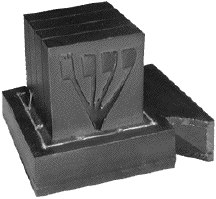
(
You'd be surprised how hard it is to find an image of teffilin shel rosh from the other side.)
Gemara Menahot 35a
ואמר אביי שי"ן של תפילין הלכה למשה מסיני
Rambam Hilkhot Tefillin 3:3
עושין מן העור דמות שי"ן שיש לה שלושה ראשין מימין המניח תפילין, ודמות שי"ן שיש לה ארבעה ראשין משמאל
Shulhan Arukh Orah Hayyim 32:42
שי"ן של תפילין, הלכה למשה מסיני שיעשה בעור הבתים של ראש כמין שי"ן בולטת מקמטי העור, אחד מימינו ואחד משמאלו. של ימין המניח, של ג' ראשים, ושל שמאל המניח, של ארבע ראשים
Just why is there a shin,
ש with three heads and a shin,
ש with four heads on the tefillin shel rosh?
Commenter
Aryeh Herzig mentions an interesting thought, quoting Yaakov Elman:I heard in the name of Yaakov Elman that the two shins on tefilin shel rosh may be the halacha- lmoshe -misinai - way of preserving the 3-lined shin of ashuri and the 4-lined shin of ivri (looks like a W )
No doubt there is more to this thought, and I'd like to know exactly what Elman said. But this is a quite interesting idea that should be further explored.
Edit, Monday 5/1/06:
I wrote Prof. Elman, and this is what he replied:
>I suggested that one possibility is that it represents the Old Hebrew shin that looks like a double-u. According to Mar Zutra or Mar Ukva (in Sanhedrin 21b-22a), this was the kesav the Torah was given in. if this is so, I suggested that this represented Torah shebikhtav, while kesav Ashuri, brought in by Ezra ha-Sofer, represents Torah shebe'al Peh, all according to the shittah of R. Tzadok Hakohen of Lublin (for exaple in Resisei Laylah on Hanuka). Putting on tefillin represents the joining of the two Toros.
Regards, Yaakov Elman
I'm glad to accurately present his very interesting idea.






No comments:
Post a Comment